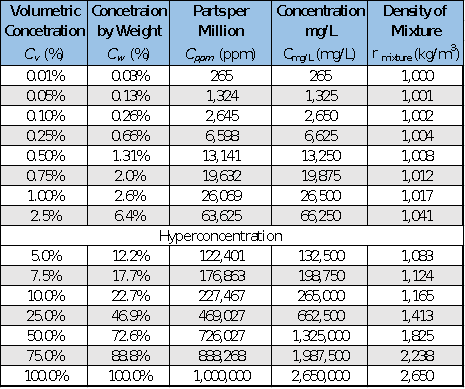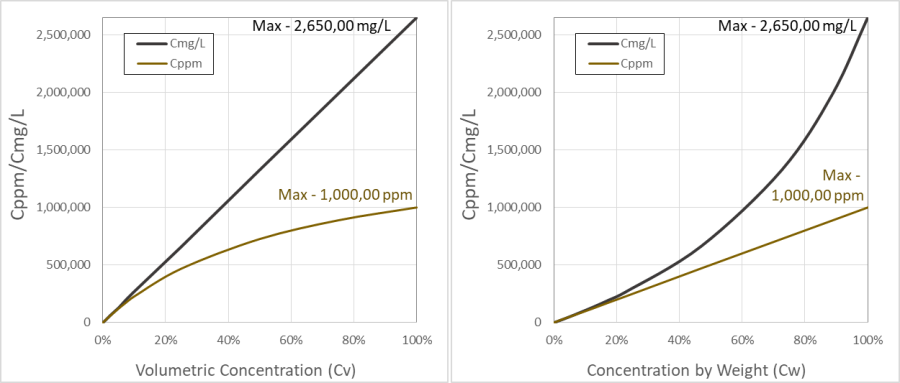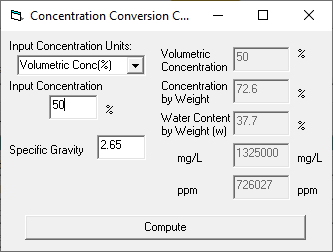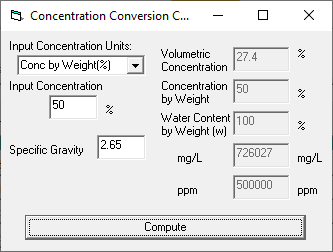Download PDF
Download page Concentration.
Concentration
Volumetric concentration is the first variable the user must estimate. Most of the non-Newtonian models are very sensitive to the volumetric concentration. Some of the other parameters can even be estimated with empirical equations with concentration in the exponent, making results even more sensitive to this variable. Enter the volumetric concentration in percent at the top of the Non-Newtonian editor. The current version of HEC-RAS uses one volumetric concentration for all time and space. We are working on a time-series of concentration and, eventually, more sophisticated methods for routing concentration through the model. Select the single concentration that is most appropriate for the modeling objectives.
The following sections describe how to compute the volumetric concentration from other concentration measurements and a few methods to estimate this variable.
Warning
One of the most common errors in this editor is defining volumetric concentration as a decimal instead of a percent. For example, in the previous figure, entering concentration as 0.692 would register as less than 1% solids, which would produce almost no debris flow effects.
Converting Concentration
There are several different ways to report concentration. At low concentrations, like those encountered in almost all natural, fluvial, sediment transport conditions, the different concentration conventions are close enough that practitioners use them interchangeably and often without distinction. But as the solid fraction of geophysical and hyperconcentrated flows increases, the difference between the specific gravity of sediment and water makes concentration by mass, volumetric concentration, and parts per-million (ppm) diverge.
Concentration by weight (Cw) is greater than volumetric concentration (Cw) because soil is denser than water. The table below (after a table in Julian 2010) demonstrates how the four primary concentration conventions interact (with the total mixture density) as the solid content increases.  At low concentrations (<5%) the differences yields trivial divergence between ppm and mg/L. For example, at Cv=5%, Cw is 12.2%, but the concentration in ppm and mg/L units only differ by about 8%. However, when the half of the volume of the mixture is solid, 73% of the weight is solid, and the Cmg/L is almost twice the ppm.
At low concentrations (<5%) the differences yields trivial divergence between ppm and mg/L. For example, at Cv=5%, Cw is 12.2%, but the concentration in ppm and mg/L units only differ by about 8%. However, when the half of the volume of the mixture is solid, 73% of the weight is solid, and the Cmg/L is almost twice the ppm.  The conversion between concentration by weight and parts-per million is the simplest conceptually. Cppm is six orders of magnitude greater than Cw (or Cppm=106Cw).
The conversion between concentration by weight and parts-per million is the simplest conceptually. Cppm is six orders of magnitude greater than Cw (or Cppm=106Cw).
Equations for converting (Julian, 2010) between Cv and Cw are:
| C_{volume} = \frac{C_{wieght}}{sg-(sg-1)C_{weight}}; \space \space C_{weight} = \frac{sg \times C_{volume}}1+(sg-1)C_{volume}} |
where sg is the specific gravity of the solid (2.65 assumed). Therefore, the concentration by weight for a mixture that is half solid by volume is:
| C_{weight} = \frac{2.65 \times 50 \%}{1+(2.65-1) 50\%} = 73\% |
A mixture cannot have more than one-million parts per million, but the maximum mg/L concentration is 2,650,000 mg/L. Both of these end cases are solid rock.
Concentration Calculator
Because there are at least four concentration conventions, There are actually more, because "concentration" is often embedded in various density conventions (e.g. density of the solids or density of the mixture), or water content. these concentrations vary dramatically for non-Newtonian mixtures, and the non-Newtonian equations are very sensitive to concentrations, it is critical that users identify or compute the Volumetric Concentration to input into HEC-RAS (see the figure at the top of this page). To help users and project teams navigate the concentration options, HEC-RAS includes a Concentration Conversion Calculator. Press the button labeled Convert Conc to launch the Concentration Conversion Calculator.  The Concentration Conversion Calculator requires three inputs. The Concentration the input concentration convention (users can choose from five options) and the specific gravity of the solids (default = 2.65). Specify these three inputs and press Compute. The calculator will generate the concentrations in Cv, Cw, w Water content by weight. Note, the equation for water content by weight from Julian (2010) (w=(1-Cv)/sg Cv) is only useful for significantly hyperconcentrated mixtures. It reports water contents above 100% for lower concentrations, and the calculator caps these at 100%., mg/L and ppm.
The Concentration Conversion Calculator requires three inputs. The Concentration the input concentration convention (users can choose from five options) and the specific gravity of the solids (default = 2.65). Specify these three inputs and press Compute. The calculator will generate the concentrations in Cv, Cw, w Water content by weight. Note, the equation for water content by weight from Julian (2010) (w=(1-Cv)/sg Cv) is only useful for significantly hyperconcentrated mixtures. It reports water contents above 100% for lower concentrations, and the calculator caps these at 100%., mg/L and ppm.

Estimating Concentration
Estimating the volumetric concentration of a mud or debris flow is difficult, but there are a couple major approaches. For forensic analysis, estimating the total deposits and pass through load yields the total mass transported, which can be distributed over a hydrograph to compute a concentration. The total deposits can be calculated by comparing pre-event and post-event LiDAR or by inferring the mass of the deposits from maintenance records.
For predictive models, there are several regression equations that estimate post-wildfire debris yields and estimating the volume of solids in a mine tailings impoundment and making credible assumptions about the volume of those solids that would be mobilized, the flow that would mobilize them, and how the solids would be distributed over the hydrograph, will help modelers estimate an approximate Cv.
Modeling Note
The post-wildfire debris load equations are included in the recent release version of HEC-HMS.